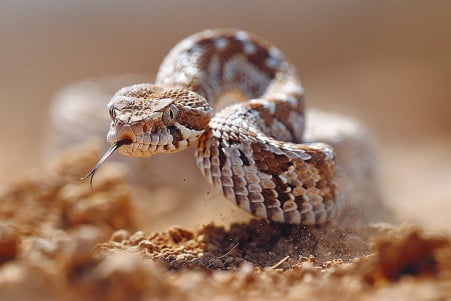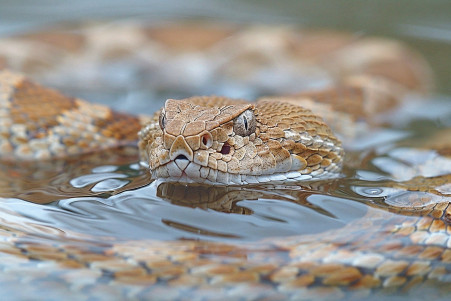How Fast Are Snakes? The Top Speeds of 10 Different Species
2 May 2024 • Updated 1 May 2024

So, how fast can these serpents really go, and what determines a snake's speed? It turns out that snakes are neither inherently fast nor slow, and their speed is largely determined by their species and the circumstances. That said, most snakes travel at an average speed of 5 miles per hour, with some of the fastest snakes, like the black mamba, reaching speeds of over 12 miles per hour. That said, snakes are sprinters, not long-distance runners, so even the fastest snakes can only keep up their pace for a short period of time.
We'll take a look at the biological evidence for the physical factors that determine snake speed and agility. This will help you better understand the factors that determine how fast a snake can move, including body shape, muscle composition, and hunting strategies, and will give you a better idea of the surprising speed of these animals. These studies will also help you understand why some snakes are so fast while others are much slower.
How fast are snakes?
Biomechanics of Snake Locomotion
Snakes have evolved an incredible array of locomotion patterns that help them move quickly and nimbly. According to research cited by Nature, the most important patterns are lateral undulation, sidewinding, concertina movement, and rectilinear locomotion. All of these patterns require the snake to use its muscles and body in a certain way to move quickly and efficiently.
Lateral undulation, which is explained in this paper, involves waves of muscle contractions that move down the snake's body to push it forward. Sidewinding, which is detailed in another study, requires parts of the snake's body to push against the ground while other parts arch up and forward. Concertina locomotion, which is discussed in this review, involves the snake's body pushing and pulling in an alternating pattern.
One of the most important factors in snake locomotion is the snake's ventral scales, which, as PNAS describes, create anisotropic friction that allows the snake to move forward but resists backward movement. In addition, the same paper explains that the shape of the snake's body and the arrangement of its muscles can make it more or less adept at certain types of locomotion, which can affect its overall speed. These biological factors help explain the snake's incredible speed and agility.
Evolutionary Specializations for Speed
Snakes have evolved much faster than other reptiles, and they have developed a number of specializations that make them faster and more agile. According to Science Friday, these specializations include limb reduction, skull kinesis, and the evolution of their chemical senses. These specializations, which are detailed in a study from the Natural History Museum, have allowed snakes to evolve to target a wide variety of prey and fill many different ecological niches.
Snakes have also evolved a number of specializations in their body shape, teeth, and strike behaviors, as explained in this Live Science article. For example, a study cited by Science showed that "strikers" like boa constrictors have specialized teeth and extremely fast strikes, while "lungers" like king snakes have wider teeth and slower strikes. These specializations determine the force, speed, and success of a snake's strike when hunting different types of prey.
The University of Michigan News explains how these specializations have allowed snakes to evolve and fill a wide variety of ecological niches. From venomous cobras to constricting pythons, the specializations that have evolved in snakes have made them "winners" in evolution compared to other reptiles.
How Fast Are Snakes Compared to Other Animals?
The cheetah may be the fastest animal on land, with a top speed of over 70 mph according to Infoplease, but some birds, including the peregrine falcon, can reach even higher speeds when diving. According to Britannica, the peregrine falcon can dive at speeds of more than 200 mph, and may even be able to reach 350 mph, although this latter figure has never been confirmed.
By contrast, the black mamba is one of the fastest snakes, but it can only reach speeds of about 12 mph according to Guinness World Records. Even though snakes aren’t the fastest animals, they are still fast for animals that don’t have legs. As Live Science observes, no other animal on land can come close to the cheetah’s top speed of 70 mph, which shows just how agile snakes are even though they don’t have legs.
In the Wild: How Snakes Use Their Speed
Snakes’ speed and agility help them catch prey and escape predators in the wild. For example, as explained in research from The Conversation, some snakes have the ability to move in completely straight lines, which helps them quickly move into tight spaces to find food or shelter. This kind of movement is especially important for snakes with heavier bodies, such as boas.
When hunting, snakes often use quick strikes to capture fast-moving, small prey like frogs and rodents. According to a study in the Journal of Herpetology, defensive strikes that are used to avoid predators are faster and cover more distance than offensive strikes that are used to capture prey. This helps snakes keep a safe distance between themselves and potential predators.
In fact, some snakes, such as the Cuban boa, have even developed group hunting behaviors that take advantage of their speed and agility. For example, as explained in The Conversation article, Cuban boas will line up on the ceilings of caves to form a wall that increases the likelihood that they will be able to capture bats as they fly by. These behaviors show how snakes have adapted their speed and agility to develop specialized hunting behaviors.
Conclusion: The Amazing Speed of Snakes
Despite their lack of limbs, snakes are able to move with speed and agility. This is due in part to the different ways that snakes move, including lateral undulation, sidewinding, and concertina movement. As noted in a study cited by Nature, even the fastest snakes, such as the red racer, can move at speeds of more than 3 mph, while the slowest, such as the Californian boa, may only move at 0.25 mph.
These differences in speed are the result of evolutionary adaptations, as discussed in reports from Science Friday and the Natural History Museum. These adaptations, including limbless bodies, flexible skulls, and acute senses, have enabled snakes to become successful predators in a variety of ecological niches.
Although snakes aren’t the fastest animals on land, their speed is impressive given their unique anatomy. As Live Science observes, no other limbless animals can move as quickly and efficiently as snakes. Research into the biomechanics and evolutionary pressures that have shaped snake speed helps scientists better understand the animals’ biology and behavior.


